Monday, March 8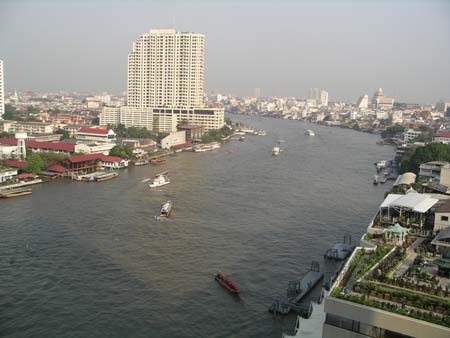
Paula and Steve: Our first full day in Bangkok gave us
a good feel for this busy metropolis. We started the day by riding down the
Chao Phraya River on a long-tail boat. The Chao Phraya River runs through
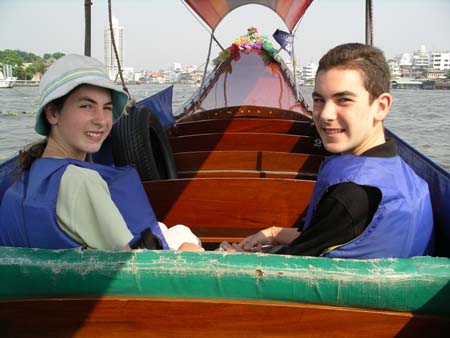 the
heart of the city and we found not only that many people live along the hundreds
of canals that extend off the river but that it is a main thoroughfare - we
were on and off various boats on the river at least six times today.
the
heart of the city and we found not only that many people live along the hundreds
of canals that extend off the river but that it is a main thoroughfare - we
were on and off various boats on the river at least six times today.
The river is quite wide and the water is surprisingly rough. We found the
ride on the long-tail boat to be much more of an adventure than we expected,
as the captain would go slowly at times and then gun the engine to cut through
the wakes left by other boats. As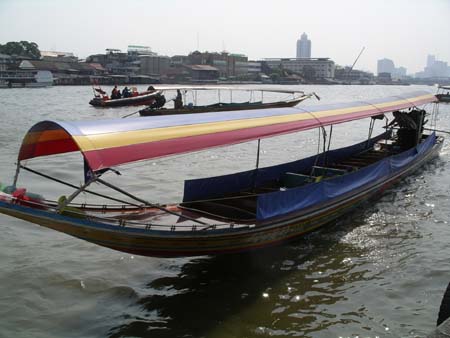 we traversed the waves from other boats, we were often sprayed. Unfortunately,
the river is polluted (and brown), and litter floats on the surface. We saw
trash boats with nets to scoop up the litter. Annie, our
we traversed the waves from other boats, we were often sprayed. Unfortunately,
the river is polluted (and brown), and litter floats on the surface. We saw
trash boats with nets to scoop up the litter. Annie, our 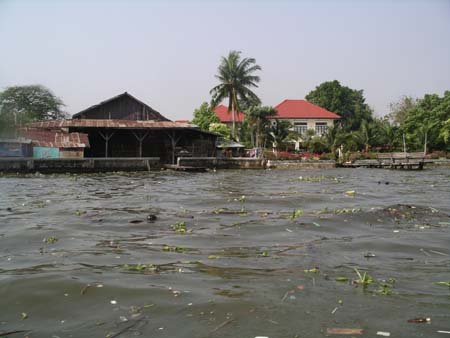 guide,
told us that the long-tail boats (called this after the long pipe that runs
off their engines) are often called "James Bond Boats" by the Thais
because the boats appeared in the movie "The Man with the Golden Gun".
guide,
told us that the long-tail boats (called this after the long pipe that runs
off their engines) are often called "James Bond Boats" by the Thais
because the boats appeared in the movie "The Man with the Golden Gun".
The narrower canals are more pleasant than the main river and reminded us
a bit of the canals in Venice - Bangkok is sometimes called the "Venice
of Asia". About 10,000 people still live along the canals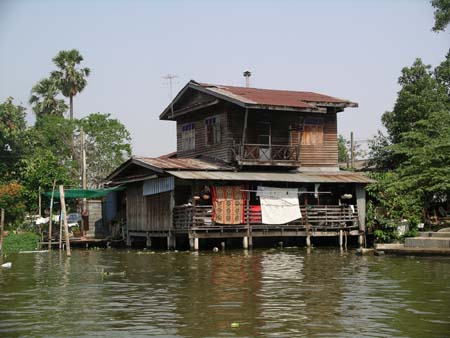 in small homes on stilts. Annie told us that most of the people living along
the canal are quite poor. We saw people washing clothing, dishes and even
rising vegetables in the canal as we rode by. The homes have open porches
with birds in cages, potted plants and flowers. Some even have vegetable gardens
growing right in the water. We also saw small neighborhood stores along the
canals and mailboxes right on shore. Women on boats sold vegetables and noodle
soup.
in small homes on stilts. Annie told us that most of the people living along
the canal are quite poor. We saw people washing clothing, dishes and even
rising vegetables in the canal as we rode by. The homes have open porches
with birds in cages, potted plants and flowers. Some even have vegetable gardens
growing right in the water. We also saw small neighborhood stores along the
canals and mailboxes right on shore. Women on boats sold vegetables and noodle
soup.
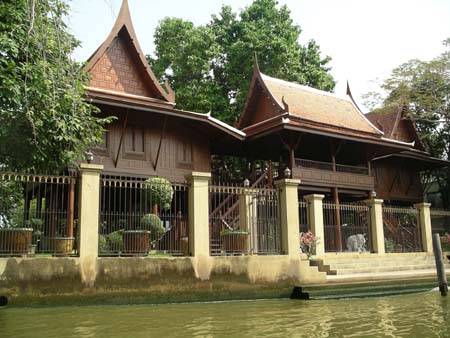 The
kids had fun seeing very large lizards along the edge of the water and feeding
the many giant catfish that live in the river. The catfish in front of the
wats (temples) that line the river are always larger because Buddhism doesn't
allow fishing in front of the wats. The fish stay in these areas knowing they
are safe (and they'll get fed).
The
kids had fun seeing very large lizards along the edge of the water and feeding
the many giant catfish that live in the river. The catfish in front of the
wats (temples) that line the river are always larger because Buddhism doesn't
allow fishing in front of the wats. The fish stay in these areas knowing they
are safe (and they'll get fed).
We stopped at the Wat of Arun which means Temple of the Dawn. This 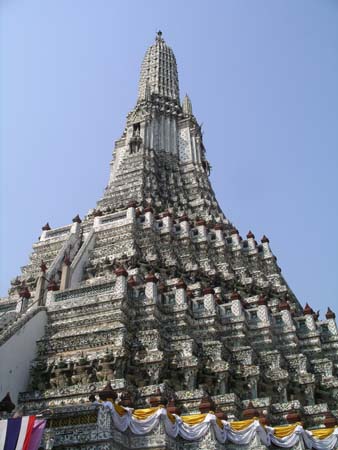 wat
was built in 1782 and the pagoda is a combination of Chinese and Cambodian
styles. The pagoda is decorated with pieces of china plates, tea cups, shells
and small tiles. Small bells surround the top of the pagoda and are believed
to be the voices of the angels. About 500 monks live in this temple and David
and Katie decided to receive the monk's blessings in the temple before we
left. As we had
wat
was built in 1782 and the pagoda is a combination of Chinese and Cambodian
styles. The pagoda is decorated with pieces of china plates, tea cups, shells
and small tiles. Small bells surround the top of the pagoda and are believed
to be the voices of the angels. About 500 monks live in this temple and David
and Katie decided to receive the monk's blessings in the temple before we
left. As we had  experienced
in Pushkar, the monk gave blessings while sprinkling them with holy water
and then gave them cotton bracelets.
experienced
in Pushkar, the monk gave blessings while sprinkling them with holy water
and then gave them cotton bracelets.
Similar to Laos, Buddhism is practiced by the majority here and each family strives to have at least one son trained as a monk to ensure their own entry into heaven (sometimes they're a monk only for 2 weeks, but this is enough). Annie told us that many boys attend the monastery with a group of their friends for the three months of school vacation - like a summer camp!
After completing our river excursion, we walked through a small local market
with people selling a huge variety of fruits, vegetables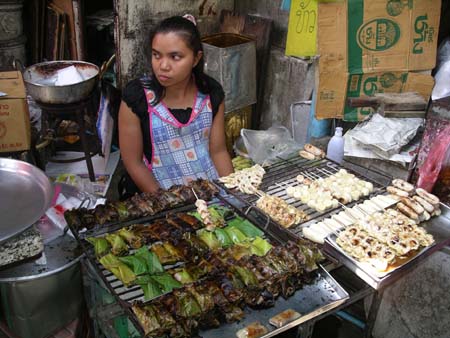 and prepared foods. Many of these were new to us, and we're looking forward
to exploring larger markets both in Bangkok and in the countryside tomorrow.
and prepared foods. Many of these were new to us, and we're looking forward
to exploring larger markets both in Bangkok and in the countryside tomorrow.
There are over 40,000 temples in Thailand and you can't scan the Bangkok
skyline for long without seeing one. Although we have seen many temples in
the past month, none of them compared to The Grand Palace and Temple of the
Emerald Buddha. This temple is considered to 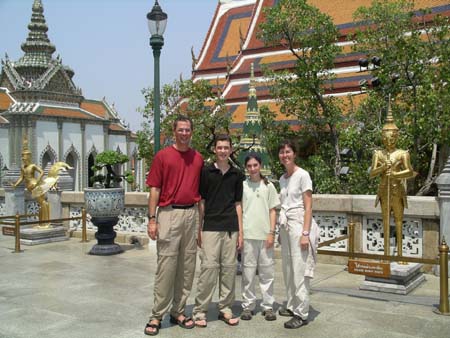 be
the most important Temple in Thailand and is used by the Royal Family. The
complex includes the royal residence, throne hall and government buildings.
The monastery complex includes a golden temple thought to house the ashes
of Lord Buddha as well as a beautiful temple containing the famous Emerald
Buddha. The Emerald Buddha was originally in Laos but brought to Bangkok by
King Rama I after a victory in Vientiane. It is only 26 inches tall and sits
on an
be
the most important Temple in Thailand and is used by the Royal Family. The
complex includes the royal residence, throne hall and government buildings.
The monastery complex includes a golden temple thought to house the ashes
of Lord Buddha as well as a beautiful temple containing the famous Emerald
Buddha. The Emerald Buddha was originally in Laos but brought to Bangkok by
King Rama I after a victory in Vientiane. It is only 26 inches tall and sits
on an 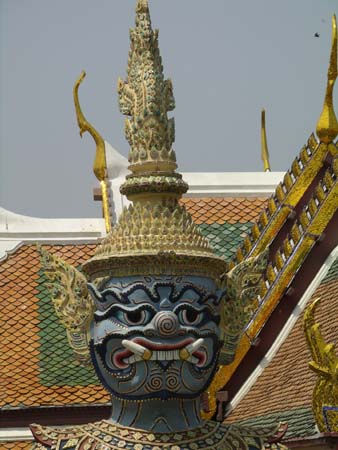 ornate
throne within the wat. It is actually made of jade and has three different
costumes it wears depending on the season. Each of these costumes is made
of pure gold and can only be changed by the royal family.
ornate
throne within the wat. It is actually made of jade and has three different
costumes it wears depending on the season. Each of these costumes is made
of pure gold and can only be changed by the royal family.
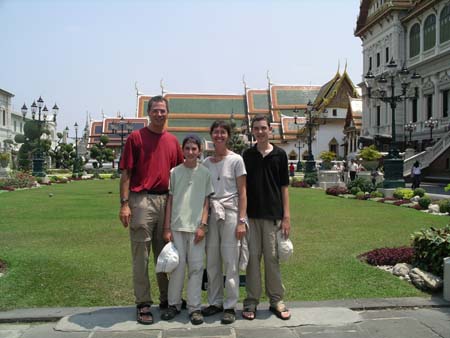 The
entire wat complex is spectacular, and gold leaf paintings and tiny colored
mirrors of red, blue, green, yellow and white are used to create a jeweled
effect on each of the buildings. In addition, large colorful mythical creatures
and good demons guard each of the entrances and all face Buddha.
The
entire wat complex is spectacular, and gold leaf paintings and tiny colored
mirrors of red, blue, green, yellow and white are used to create a jeweled
effect on each of the buildings. In addition, large colorful mythical creatures
and good demons guard each of the entrances and all face Buddha.
There are also many bronze elephant statutes which have clearly been 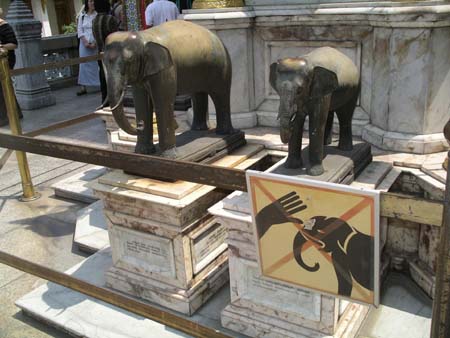 rubbed
by many visitors despite the signage asking that they not be touched. Annie
told us that rubbing an elephants head is thought to bring good luck here
in Thailand.
rubbed
by many visitors despite the signage asking that they not be touched. Annie
told us that rubbing an elephants head is thought to bring good luck here
in Thailand.
After leaving the Grand Palace, we had another great Thai meal from a restaurant
along the river. So far, we have really enjoyed the food, but always have
to ask for "n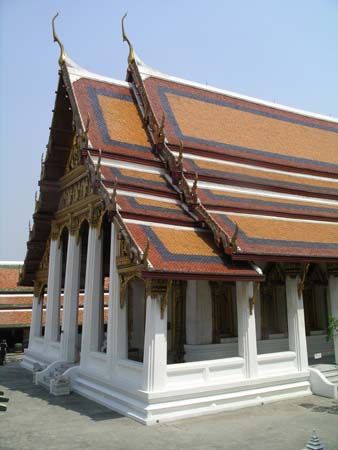 ot
too spicy!" Annie showed us how "real Thais" eat their food
- she ordered her own plate of Pad Thai (with the normal amount of spice served
- no way was she going to eat any of the mildly spicy version that we had
already ordered…), and then proceeded to dump almost an entire small
bowl of chili powder into her dish. Then she told us that she's in the small
minority of Thais who like their food only "mildly spicy" - 90%
of
ot
too spicy!" Annie showed us how "real Thais" eat their food
- she ordered her own plate of Pad Thai (with the normal amount of spice served
- no way was she going to eat any of the mildly spicy version that we had
already ordered…), and then proceeded to dump almost an entire small
bowl of chili powder into her dish. Then she told us that she's in the small
minority of Thais who like their food only "mildly spicy" - 90%
of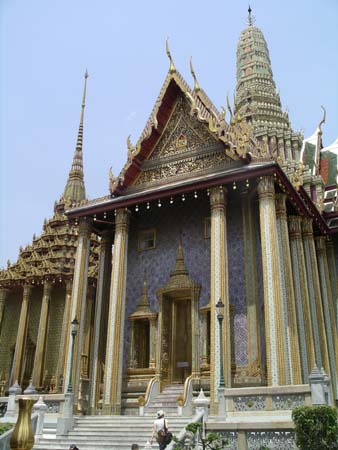 people here would want it much spicier than she. We couldn't believe it!
people here would want it much spicier than she. We couldn't believe it!
Next was a short visit to a downtown store that sells all varieties of Thai handicrafts. We quickly fell in love with the hand-painted glassware, and bought two pieces that are being shipped home.
Finally, we took a "Sky Train" tour through the center of Bangkok. The Sky Train is a modern above-ground train that is the best way to see the city while avoiding the terrible traffic (and heat). Bangkok has 4 million cars that cram its roads. There's no subway (one is being built now, and is scheduled to open next month), and Annie told us that travel anywhere in the city is a nightmare. We saw much evidence of these traffic problems today.
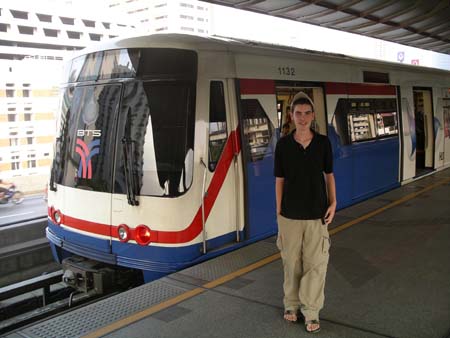 Bangkok
is certainly the very busy city that we expected. Its skyline is filled with
tall office buildings, hotels and apartments, but certainly not to the extent
of some of our largest cities like New York or Chicago. There's a tremendous
amount of sprawl - the city extends for miles. Many of the apartments are
nondescript white cement high rises with the numerous colorful temples providing
the main focuses of interest. We learned that while rents range from $100-800/month,
average apartments not far from the city can be found for about $200/month.
Bangkok
is certainly the very busy city that we expected. Its skyline is filled with
tall office buildings, hotels and apartments, but certainly not to the extent
of some of our largest cities like New York or Chicago. There's a tremendous
amount of sprawl - the city extends for miles. Many of the apartments are
nondescript white cement high rises with the numerous colorful temples providing
the main focuses of interest. We learned that while rents range from $100-800/month,
average apartments not far from the city can be found for about $200/month.
As we headed back to our hotel, we talked to Annie about the tourism industry.
She told us that before September 11th, 80% of tourists in Thailand were from
America but that percentage has dropped to 5% (it's getting a little better
now). Most of the tourists come from Germany and Japan. Interestingly, we
have noticed many golf  courses
in the city and Annie says these are for the tourists not for the Thai people.
They come here to golf because it is cheaper!
courses
in the city and Annie says these are for the tourists not for the Thai people.
They come here to golf because it is cheaper!
Annie also told us that the Thai people who live in Bangkok spend their free time in the large malls throughout the city. This is primarily to avoid the heat and pollution. She described the malls as places to not only shop but also see movies, bowl, go to the fitness and internet centers as well as visit the health clinic or dentist. The average income of people in Bangkok is about $3,000/year. While this seems quite low, income in the countryside is only $300/year.
Life outside Bangkok is quite different and after spending the day in the city, we are looking forward to visiting the countryside tomorrow.
